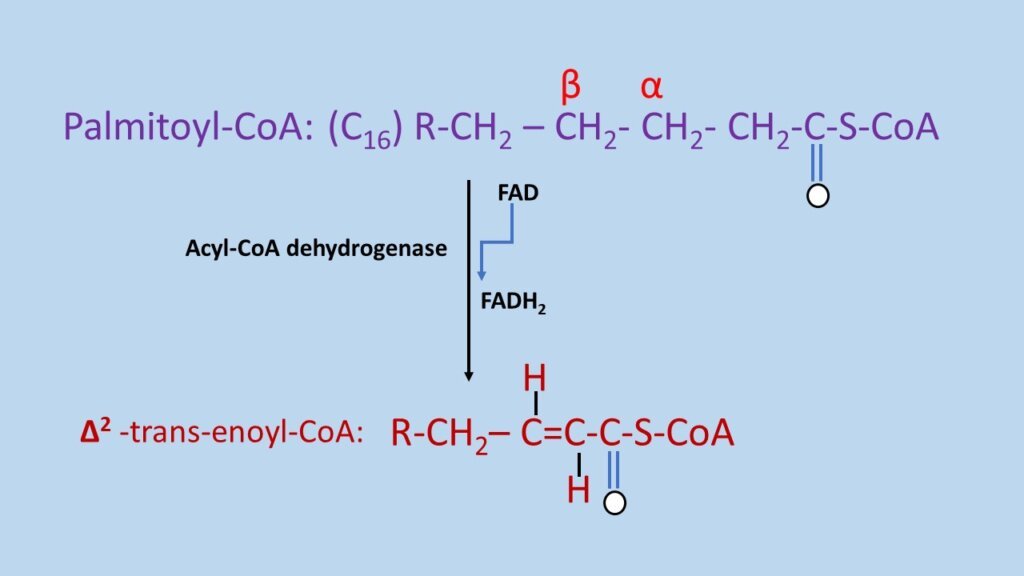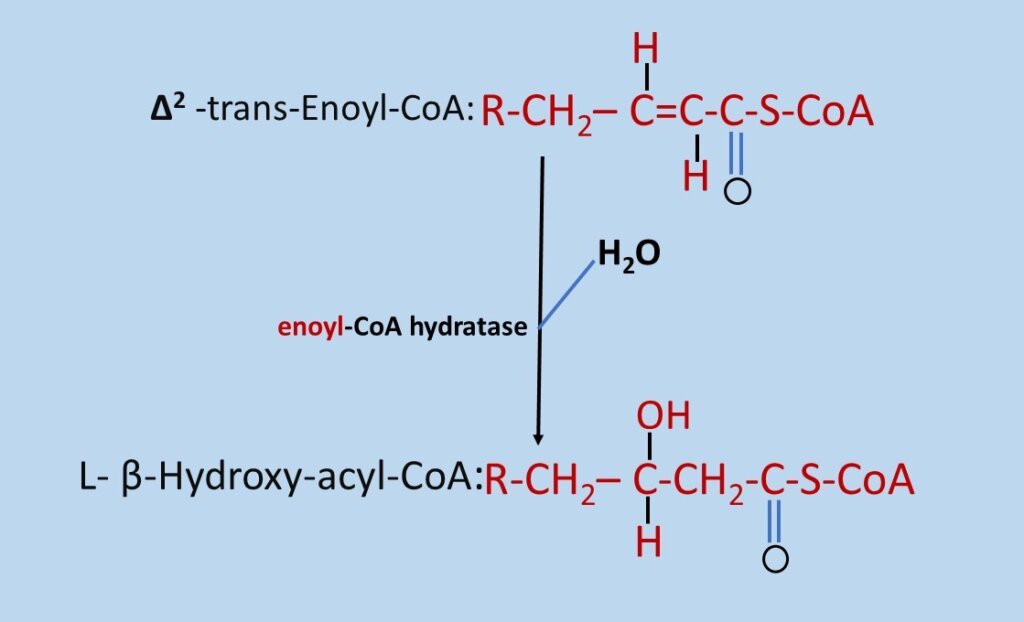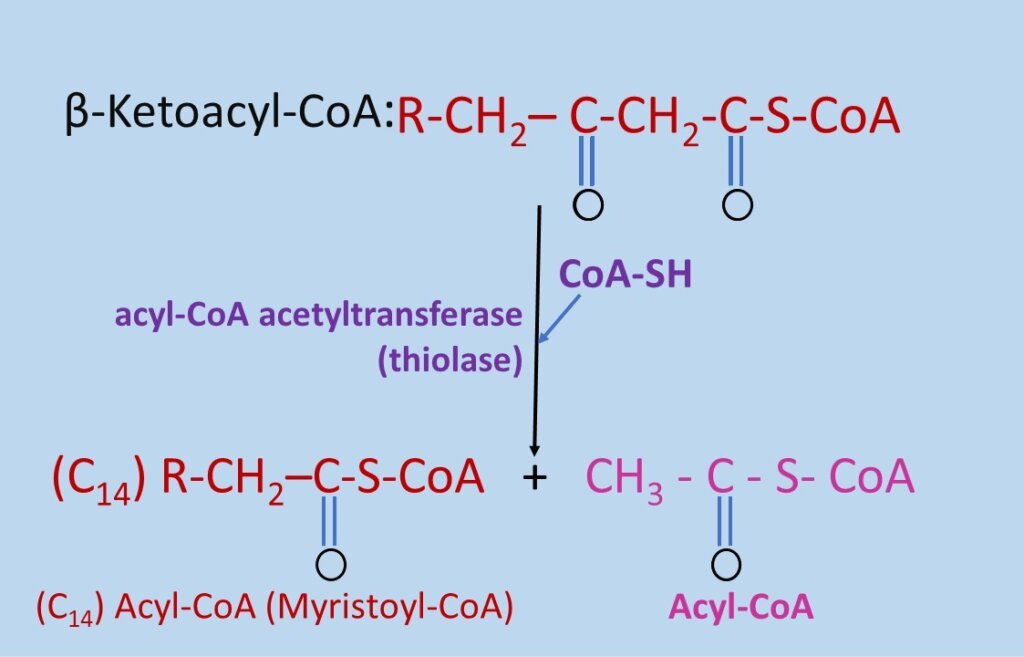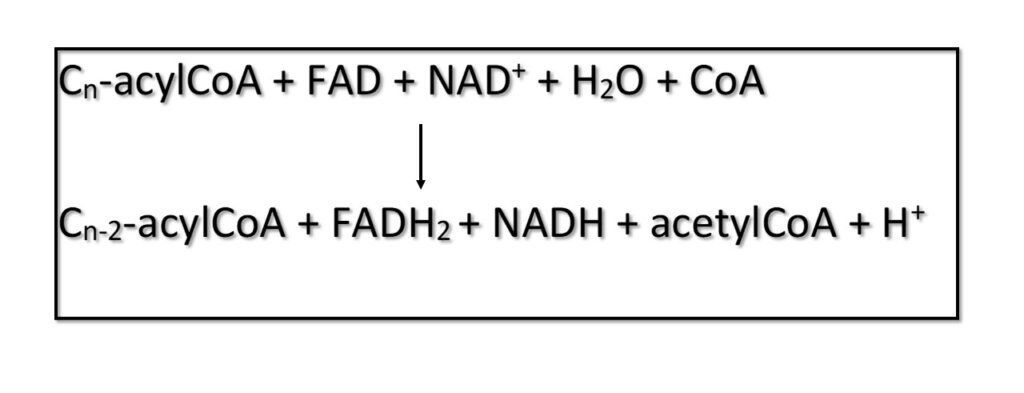INTRODUCTION:
Fatty acids are the Fats. Fats are important source of energy as (1gm of fat gives 9 kcal energy). Mainly as triacylglycerols (triglycerides) in adipose cells (Adipose cells: synthesize and contain large globules of fat). Fats constitute 84% of stored energy where as Protein – 15% and Carbohydrate (glucose or glycogen) – <1%
β-oxidation of fatty acid is the break down of a fatty acid to acetyl-Coa. Example of fatty acid is the palmitic acid. This process occurs in the mitochondria. Process is strictly aerobic. After production Acetyl-CoA is fed directly into the Krebs cycle. It occurs in many tissues including liver, kidney and heart. Fatty acids oxidation doesn’t occur in the brain
There are several types of fatty acids oxidation.
(1)β-oxidation of fatty acid (2)α-oxidation of fatty acids (3)ω- oxidation of fatty acids
Q.1 who proposed β-oxidation theory? (1 mark)
Ans: German chemist Franz Knoop in 1904 proposed β-oxidation theory
Q.2 State the name of enzymes participated in β-oxidation pathway.
Ans. Acyl COA synthetase, AcylCoA dehydrogenase, Enoyl CoA hydratase, 3-hydroxyacyl-CoA dehydrogenase, AcylCoA acetyltransferase (thiolase)
Q.3 Describe β-oxidation of fatty acid (5 marks)
During fatty acid oxidation the fatty acyl chain is shortened by two carbon atoms and FADH2, NADH and acetyl Co A are generated. This process is known asβ-oxidation because oxidation occurs on the β carbon and the chain is broken between the α (2)- and β (3)-carbon atoms.
The beta oxidation of fatty acids involve three stages :
- 1. Activation of fatty acids in the cytosol
- 2. Transport of activated fatty acids into mitochondria through carnitine shuttle
- 3. Beta oxidation occurs in the mitochondrial matrix
1)Actication of FA (Fatty Acids): Activation is processed by FA thiokinase (acyl COA synthetase) present in cytosol. Thiokinase requires ATP, COA SH, Mg++. The product of this reaction is FA acyl COA and water.
2. Transport of fatty acyl CoA from cytosol into mitochondria:
Fatty acids are activated in the cytosol, whereas they are oxidized in the mitochondrial matrix. So this activated Fatty acids (i.e FA acyl CoA) has to be transferred to the mitochondria. So the long chain acyl CoA passes to the inner mitochondria membrane with a special transport mechanism called Carnitine shuttle (carnitine is a kind of zwitterionic alcohol. It is found in the muscle and obtained from the food).
ROLE OF CARNITINE :
- The acyl group of FA is conjugated with the hydroxyl group of carnitine to form acyl carnitine. This reaction is catalyzed by carnitine acyl transferase I.
- Acyl carnitine is then shuttled across the inner mitochondrial membrane by a translocase.
- The acyl group is transferred back to CoA on the matrix side of the membrane. This reaction, which is catalyzed by carnitine acyl transferase II.
- Finally, the translocase returns carnitine to the cytosolic side to exchange for an incoming acyl carnitine.
There are 4 steps in β – oxidation:
Step-1: Dehydrogenation – The first step is the removal of two hydrogen atoms from the 2(α) and (β)- carbon atoms, catalyzed by acylCoA dehydrogenase and requiring FAD. This results in the formation of Δ2 -trans-enoyl-CoA and FADH2

Step-2 Hydration: Water is added to saturate the double bond and form 3 – hydroxyacyl-CoA. Catalyzed by Enoyl CoA hydratase enzyme.

Step-3– Dehydrogenation– The 3- hydroxy derivative undergoes further dehydrogenation on the 3 – carbon catalyzed by L(+)-3-hydroxyacyl-CoA dehydrogenase to form the corresponding 3-ketoacyl-CoA compound. In this case, NAD+ is the coenzyme involved.

Step-4- cleavage : The fourth reaction is cleavage of the two carbon fragment by splitting the bond between α and β carbons. This reaction is catalysed by thiolase enzyme.
Acetyl CoA molecule is released. This acyl CoA molecule is the substrate for the next round of oxidation starting with acyl CoA dehydrogenase. Repetition continues until all the carbons of the original fatty acyl CoA are converted to acetyl CoA. In the last round a four carbon acyl CoA (buturyl CoA) is cleaved to 2 acetyl CoA. Since acetyl-CoA can be oxidized to Co2 and water via the citric acid cycle the complete oxidation of fatty acids is achieved.

The overall reaction can be represented as follows:

Energetics of FA oxidation e.g. Palmitic (16C):
- β -oxidation of palmitic acid will be repeated 7 cycles producing 8 molecules of acetyl CoA.
- In each cycle FADH2 and NADH+H+ is produced and will be transported to the respiratory chain.
- FADH2 ————-2 ATP
- NADH + H+ _______3 ATP
- So 7 cycles 5×7 = 35 ATP 1.Each acetyl CoA which is oxidized in citric cycle gives 12 ATP (8×12=96 ATP) 2.2 ATP are utilized in the activation of fatty acid (IT occurs once). 3.Energy gain = Energy produced – Energy utilized 4.= 35 ATP + 96 ATP – 2 ATP = 129 ATP


Keep up the good work, I read few posts on this internet site and I believe that your web blog is really interesting and contains lots of superb info .
I enjoy what you guys are up too. Such clever work and coverage! Keep up the awesome works guys I’ve you guys to my personal blogroll.
Whats Going down i am new to this, I stumbled upon this I’ve discovered It absolutely helpful and it has helped me out loads. I hope to contribute & assist different users like its aided me. Good job.
I am currently writing a paper that is very related to your content. I read your article and I have some questions. I would like to ask you. Can you answer me? I’ll keep an eye out for your reply. 20bet
Please write me about your question I try my best to answer you
I do not even know how I ended up here but I thought this post was great I dont know who you are but definitely youre going to a famous blogger if you arent already Cheers